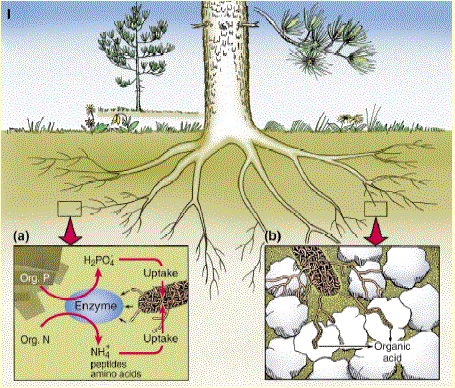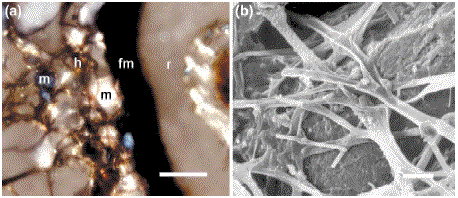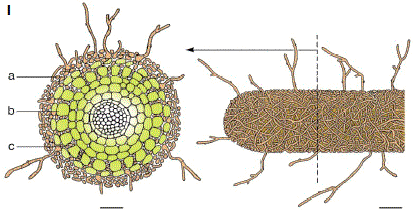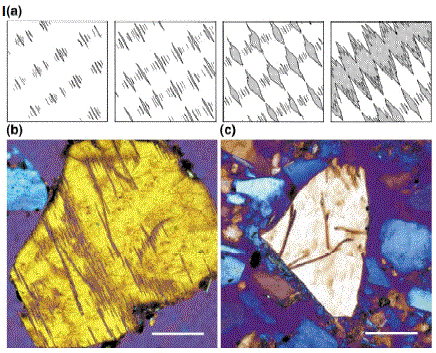
Box 3. Nutrient mobilization by ectomycorrhizal fungi
As well as the quantitative effects on plant
nutrient uptake (increase in uptake surface and exploited soil
volume), the ectomycorrhizal fungus influences the uptake of
plant nutrients in two qualitative ways:
(Fig. Ia) Via enzyme production, the ectomycorrhizal
fungus can utilize organic nitrogen (N) and phosphorous (P) forms,
which would otherwise remain largely unavailable to roots. Nutrient
mobilization from amino acids, peptides, proteins, amino sugars,
chitin and nucleic acids has been showna, together
with transfer of N and P into the host planta,b. Direct
hyphal absorption of amino acids and simple peptides can also
occura .
( Fig. Ib) The ectomycorrhizal fungus can mobilize P,
potassium (K), calcium (Ca) and magnesium (Mg) from solid mineral
substrates through organic acid excretionc,d,e. In
addition, tunnels in weatherable minerals enable ectomycorrhizal
hyphae to reach the interior of the minerals and access P from
apatite inclusions. Essential nutrients become available to the
host plant via the ectomycorrhizal myceliumc. Analogous
to their organic nutrient mobilizing capabilities, the abilities
of different ectomycorrhizal fungi to mobilize inorganic nutrients
might be species specificf.
ボックス3.外生菌根菌による栄養流動
植物の栄養摂取に対する定量的な影響(摂取表面および利用される土壌体積の増加)のほかに、外生菌根菌は二通りの定性的な方法で植物の栄養摂取に影響を与える:
(Fig. Ia) 酵素生産によって、外生菌根菌は有機窒素(N)とリン(P)化学種を利用できるが、これらの大部分はさもなければ根に利用できないままになってしまう。アミノ酸、ペプチド、蛋白質、アミノ糖、キチン、核酸からの栄養流動aが、NおよびPの親植物への輸送a,bとともに、示されてきている。アミノ酸と単純なペプチドの菌糸による直接的な吸収も起こりえるa。
(Fig. Ib) 外生菌根菌は、有機酸の排出によって固体鉱物基質からP・カリウム(K)・カルシウム(Ca)・マグネシウム(Mg)を流動させることができるc,d,e。さらに、風化しやすい鉱物中の穿孔は、外生菌根菌が鉱物内部に到達してアパタイト包有物からPを取得することを可能にする。必須栄養は外生菌根菌糸によって親植物に利用できるようになるc。それらの有機栄養流動能力と類似して、異なる外生菌根菌が無機栄養を流動させる能力は特定の種に限られるであろうf。
References
a Chalot, M. and Brun, A.
(1998) Physiology of organic nitrogen acquisition by ectomycorrhizal
fungi and ectomycorrhizas. FEMS Microbiol. Rev. 22,
21-44
b Antibus, R.K. et al. (1997) Root surface phosphatase
activities and uptake of 32Plabelled inositol phosphate
in field-collected gray birch and red maple roots. Mycorrhiza
7, 39-46
c Wallander, H. (2000) Uptake of P from apatite
by Pinus sylvestris seedlings colonized by different ectomycorrhizal
fungi. Plant Soil 218, 249-256
d Wallander, H. and Wickman, T. (1999) Biotite
and microcline as potassium sources in
ectomycorrhizal and non-mycorrhizal Pinus sylvestris seedlings.
Mycorrhiza 9, 25-32
e Wallander, H. (2000) Use of strontium isotopes
and foliar K content to estimate
weathering of biotite induced by pine seedlings colonised by
ectomycorrhizal fungi from two different soils. Plant
Soil 222, 215-229
f Lapeyrie, F. et al. (1991) Phosphate solubilizing
activity of ectomycorrhizal fungi in vitro. Can. J. Bot.
69, 342-346

Fig. 1. Hyphae linking plants to minerals. A thin-section
of (a) a
cross-sectioned ectomycorrhizal root tip illustrates how (h)
ectomycorrhizal hyphae, emanating from (fm) the fungal mantle
around (r) a root, enclose (m) mineral particles from the adjacent
soil. The direct contact between the hyphae and the mineral surface
is revealed on (b) a SEM picture of branching hyphae that
cover and penetrate a mineral particle. Scale bars = 50 μm and
10 μm respectively.
図1.植物を鉱物と結びつける菌糸。(a)横断面で切られた外生菌根尖端の薄片は、根(r)の周辺のマントル(fm)から発した外生菌根菌子(h)が隣接する土壌から鉱物粒子(m)をどのように囲い込んでいるかを示している。菌糸と鉱物表面間の直接の接触は、(b)鉱物粒子を覆って貫く、分枝した菌糸のSEM写真に示されている。バーの長さはそれぞれ50μmと10μm。
〔『Landeweert,R., Hoffland,E., Finlay,R.D., Kuyper,T.W. and
van Breemen,N.(2001): Linking plants to rocks: ectomycorrhizal
fungi mobilize nutrients from minerals. Trends in Ecology
& Evolution, 16(5), 248-254.』から〕 |



